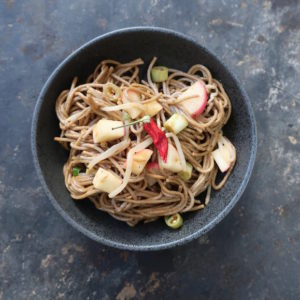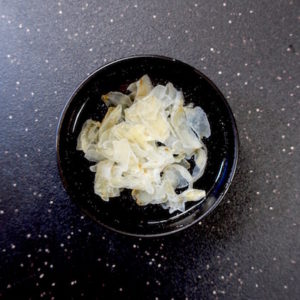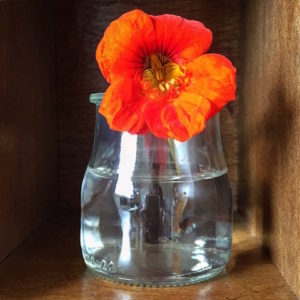Gong Bao Chicken
According to Fuchsia Dunlop, the precise origins of Gong Bao Chicken are unknown. We do know the dish is named after Ding Baozhen, who governed China’s Sichuan province during the Qing Dynasty. As Ding Baozhen was very fond of eating this dish, the chicken was cut into very small pieces to accommodate his poor teeth. How he managed to chew traditional peanuts isn’t mentioned.
Gong Bao Chicken was the first “real” Chinese food I ever ate. During the course of the meal, I consumed several hot peppers whole, choking, sneezing, and suffering terribly before identifying the pretty red things amid the chicken as the cause of my trouble. Nor did I understand that rice, not water, would have dulled the waves of capascin-induced agony.

I was about to write about what a long way I’ve traveled, but how far is that? At age fifty I know enough to avoid the California Reaper? Clearly I deserve an honorary Ph.D.

Enough philosophizing. Gong Bao Chicken. The orignal recipe comes from A. Wong, The Cookbook, authored, shockingly, by one Andrew Wong, who runs, even more shockingly, an eponymous restaurant in London. (I never thought I’d get to use the word eponymous. We have our fun where we can these days.)

In his eponymous cookbook’s introduction, Mr. Wong describes the sort of Chinese food he prepares thusly:
a lighter, modern approach that exemplifies the beauty and complexity of our cuisine yet maintains the traditional values and cultural idiosyncrasies of each recipe.
If you’re wondering what “modern” means in the context of Chinese food, round up the usual suspects: foie gras, dry ice, xanthan gum, and maltrodextrin powder. I know you have these in your cabinets. I do, too. Equipment? You’ll want a deep fryer, a cotton candy maker, and an espuma gun (Didn’t get one for your wedding? Damn. Me neither.)
What the hell is an espuma gun? I don’t know. But it’s fun to say. Espuma. If you say it really fast, repeatedly, it stops making any sense at all. Espuma. Espuma.

Despite Constance Novis’s smoothing hand, (She’s the Americanizer. Poor woman, who knew there was such a job title?) Wong’s recipe is fraught. He got it from the Sichuan Institute of Higher Cuisine, where, incidentally, Fuchsia Dunlop earned her culinary degree. And how is this Gong Bao different from all other Gong Bao’s? I thought you’d never ask. It calls for making a stock, that’s how. Said stock includes Sichuan peppercorns, black peppercorns, ginger, garlic, and chili peppers. Nowhere in the recipe are you instructed to strain said broth before pouring it over the chicken, which is eagerly waiting in the wok. Consider the alternative. Or look at the photo below.

Visual of why you should strain your Gong Bao broth before pouring it over your stir-fry. You wouldn’t wanna eat that. Really.
Once the broth is added to the wok, you’re instructed to reduce it, chicken and all. Do this, and your chicken will go from tenderly marinated cubes of deliciousness to housing material. I know. I tried it. Twice.
Look, Andrew Wong is a professional chef. He comes from a family of restauranteurs. He attended culinary school. He worked in China. I am a middle-aged white woman in a crummy kitchen who has never visited Asia. (Believe me, I would love to go. Send airfare. Come here and mind my husband. I’ll be on the next plane.) For me to criticize Wong is ridiculous. I am saying if you don’t strain this broth you’re in for an unpleasant eating experience. And that nobody enjoys overcooked chicken. Okay?

So, look. Strain the broth. Pour it over the chicken. If your broth cries out for reduction, remove the chicken from the wok first. Then blast away to your heart’s content. Once you’ve reached peak viscous, return the chicken to the wok, let your ingredients friend each other, toss those peanuts over (unless, to quote Chrissy Teigen, Timmy has peanut allergy), get your rice, and eat. You will not be sorry. This I promise you.

Gong Bao Chicken
Adapted From the A. Wong Cookbook by Andrew Wong, who got the recipe from the Sichuan Institute of Higher Cuisine
Serves 2-4
Prep time: the chicken needs to marinate for an hour before stir-frying. You can prepare the Gong Bao broth while the chicken marinates. It takes 20 minutes of simmering time. Actual stir-frying time is brief.
Please read the recipe through before cooking, including the notes at the bottom.
For the Chicken and marinade:
10 -16 ounces boneless, skinless chicken thighs, cut into small pieces: think eating with chopsticks
2 teaspoons Shaoxing rice wine
1 teaspoon light soy sauce
2 teaspoons cornstarch mixed with 2 teaspoons cold water
1 teaspoon regular or fine sea salt
For the Gong Bao Broth:
1/4 cup/2 ounces Sichuan peppercorns
1/4 cup/2 ounces black peppercorns
1/4 cup/2 ounces dried red chiles or to taste
1/4 cup/2 ounces white sugar
1/2 of a garlic bulb
3 ounces ginger root (you can be approximate)
1/2 cup/4 ounces Chinese red vinegar
1/2 cup/4 ounces light soy sauce
1/2 cup/4 ounces Shaoxing rice wine
1 cup/8 ounces water
to finish the dish:
peanut or other high heat refined oil like canola, for the wok
4 scallions, sliced into 3/4 inch lengths
1/4 cup roasted unsalted peanuts
Rice, for serving
You will need a large wok or sturdy, non-stick or well-seasoned large frying pan to make this dish. You will also need a 3-4 quart saucepan, strainer, and bowl to make the broth.
Make the marinade:
Place the sliced chicken, rice wine, cornstarch mixed with water, and salt together in a bowl, mix well to combine, and refrigerate for at least an hour.
Make the Gong Bao broth:
In a four-quart saucepan, bring the Sichuan peppercorns, black peppercorns, red chiles, white sugar, garlic bulb, ginger, red vinegar, water, soy sauce, and rice wine to a simmer for 20 minutes.
Strain by setting a strainer over a heat-proof bowl. Allow to cool, reserving the strained matter.
Start your rice.
Finish the dish:
Take the chicken out of the fridge.
Have a large dish ready.
In a large wok or frying pan, heat the peanut oil. Slide chicken into the wok and stir-fry until just cooked through. Add the scallion. Turn the heat to low.
Pick out the garlic and hot pepper from the strainer if you wish, for adding to finished dish. Discard remaining material in strainer.
Pour strained broth into the wok and increase the heat to medium, stirring to blend. If you want to reduce the broth, remove chicken to your side dish, crank up the heat, and reduce to your liking. Turn down the burner, return chicken to the wok, and stir to reheat and incorporate. Scatter peanuts over the top, and serve with rice.
Notes
The original recipe called for celery, sliced and added at the same time as the scallion. Feel free to include it. Two people simply cannot finish bunches of celery before they go limp, so I rarely buy it.
Sichuan peppercorns and red vinegar are available at Asian markets or online.
Sterilize a dirty cutting board by washing it thoroughly with warm soapy water and rubbing surfaces with a halved lemon.
I like to let the strained peppercorn/garlic/ginger cool a bit, then pick out the garlic bulb and a few whole hot red peppers. The garlic is soft and creamy. Diner can decide whether or not to cut up the pepper and add it to their meal.
The original recipe directs readers to reduce the Gong Bao broth until it coats the chicken. I find it impossible to do this without overcooking the poultry, and prefer a saucier dish. Reduce as much as you wish.
Gong Bao Chicken is Sichuanese, meaning it should be extremely spicy. But you can control how many Sichuan peppercorns and dried hot peppers you want to add. This recipe gives a medium hot result.
Leftover chicken will keep, refrigerated, up to three days. Rice is highly perishable. Cool it quickly, refrigerate it, and consume within 2 days. This should not be difficult.





